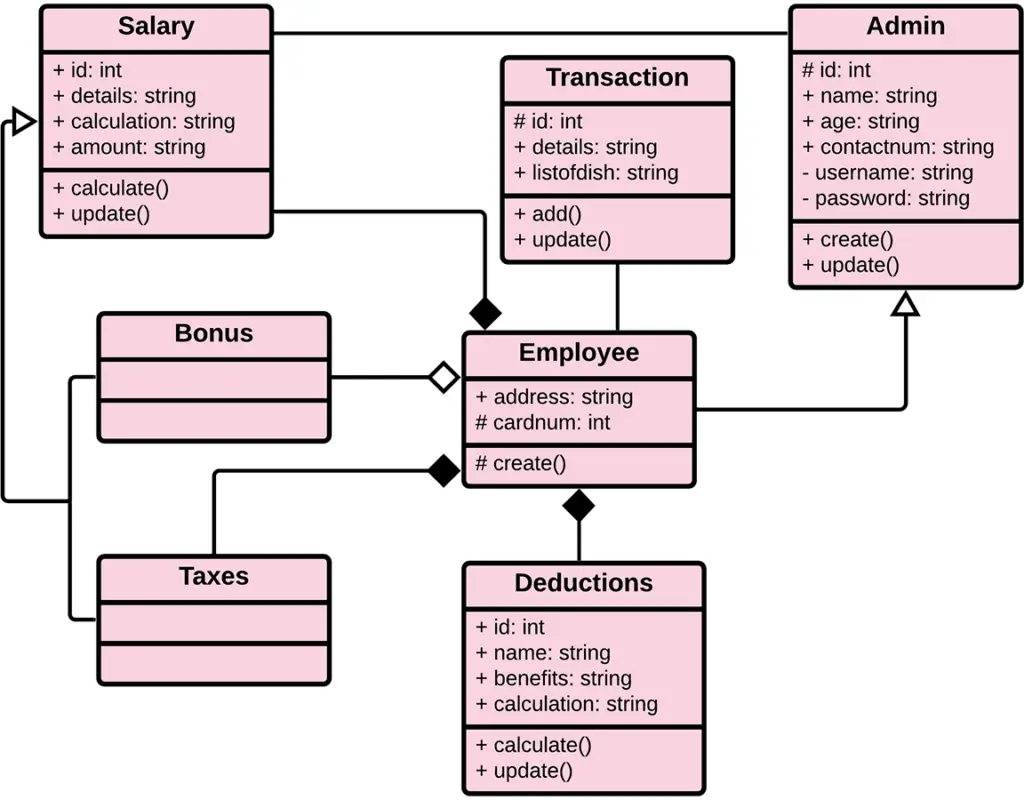A Payroll Management System Class Diagram is a picture that shows the system’s classes and how they relate to each other.
This UML Class Diagram is made to help programmers build the Employee Payroll management system. It has the class’s attributes, methods, and how classes relate to each other. These contents make sure that the way your Payroll management system is built is in line with what it should do.
Aside from that, you can learn more about Diagrams by reading the linked and suggested articles below.
- Payroll Management System UML Diagrams
- Employee Payroll System Class Diagram
- Activity Diagram for Payroll Management System
Payroll management class diagram design considerations
The payroll management system is software that lets you handle all of your employees’ financial information in an easy and automatic way. This payroll administration system takes care of employees’ wages, deductions, other forms of transportation, net pay, bonuses, and pay stubs.
Payroll processing is the process of making sure that employees get paid based on their type, status, salary, wages, and deductions. It’s also necessary to file reports with customs and pay taxes on wages. At the most important points in processing payroll, there needs to be a checkpoint to make sure nothing goes wrong.
In short, the payroll management process is how a company takes care of its employees’ financial information. The employee’s wages, incentives, bonuses, deductions, and net pay would be listed.
How to Construct Payroll Management System UML Class Diagram?
Time needed: 5 minutes
Here, we will explain how to construct Payroll Management System Class Diagram.
- Identify the class names
The first step is to identify the primary objects of the system.
So the classes that are included in an Payroll Management would be the salary, users, employees, taxes, bonuses, and transactions.
Class Attributes: The class’s attributes are found in the middle portion.
Class operations: are included in the bottom part (methods). Each action has its own line when displayed in a list format.
Class Connections: Depending on the access modifier, each class has a different level of access
Public (+)
Private (-)
Protected (#)
Package (~)
Derived (/)
Static (underlined) - Determine the targeted users
After getting used to the symbol, you’ll need to decide who you want to use it. Your project will be used by the people you want to use it.
If your project is Payroll Management System, then the admin and the employee would be your users. After that you can use this information to move on to the next step. - Analyze the activities included
The gathered information from the targeted users is very useful in creating a class diagram. You just need to evaluate these data and pick the useful classes. Then you’re ready for making a class diagram.
Take note: When you create your own class diagram, you have to be specific. That is because it will affect your project's development. Do not worry because you can use the sample given as your project reference, or you can also create your own.
Simple Class Diagram (UML) for Payroll Management System
The illustration shown in this article gives you the hint on how will you design your own UML Class Diagram. It has a simple idea of how the class Diagram works.
The classes were determined, which are symbolized by boxes. They were designated with their corresponding attributes and show the class’s methods. Their relationships are also plotted to show the connections between classes and their multiplicity.
You should also look into the visibility symbols displayed in the diagram. These are important because they declare the status of attributes in your class diagram. Some of the classes’ attributes are public (+), which means that they can be accessed by the classes connected to them.
While the protected (#) symbols mean that the attributes of the data can be accessed by the same classes or subclass, the (-) symbol means it cannot be accessed by other classes.
Here is the Class Diagram for Payroll Management System:

Tips on Designing a Class Diagram of Payroll Management System
To design your class diagram, you may use platforms and editing tools online. These tools are helpful since they already have the needed symbols to illustrate your class diagram.
You just have to plot the included actors and objects. Then you will enter the appropriate messages that the system requires.
The platforms or online tools that you may use are:
- Lucidchart
- Creately
- SmartDraw
- Edrawmax
- Canva
Conclusion
The Payroll Management System Management System is a modeled diagram that explains its classes and relationships. The diagram shows the names and attributes of the classes, as well as their links and their methods.
It is the most essential type of UML diagram, which is critical in software development. It is an approach to show the system’s structure in detail, including its properties and operations.
Inquiries
Now let me ask you something. What have you learned through the discussion? May this article help you with your projects in the future?
If you have inquiries or suggestions about Payroll Management System Class Diagram | UML just leave us your comments below.
Keep us updated and Good day!

